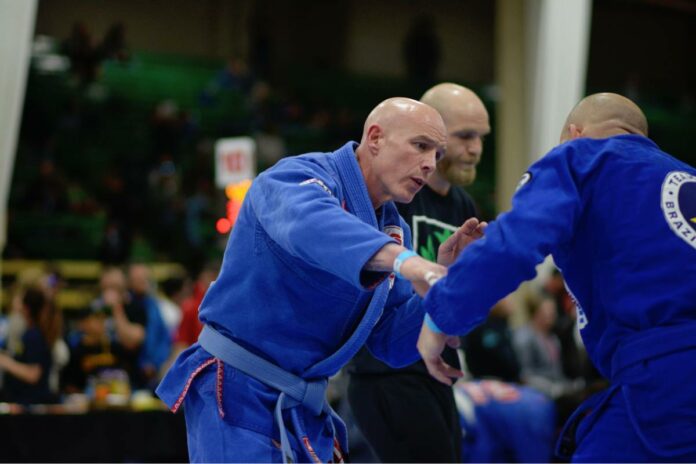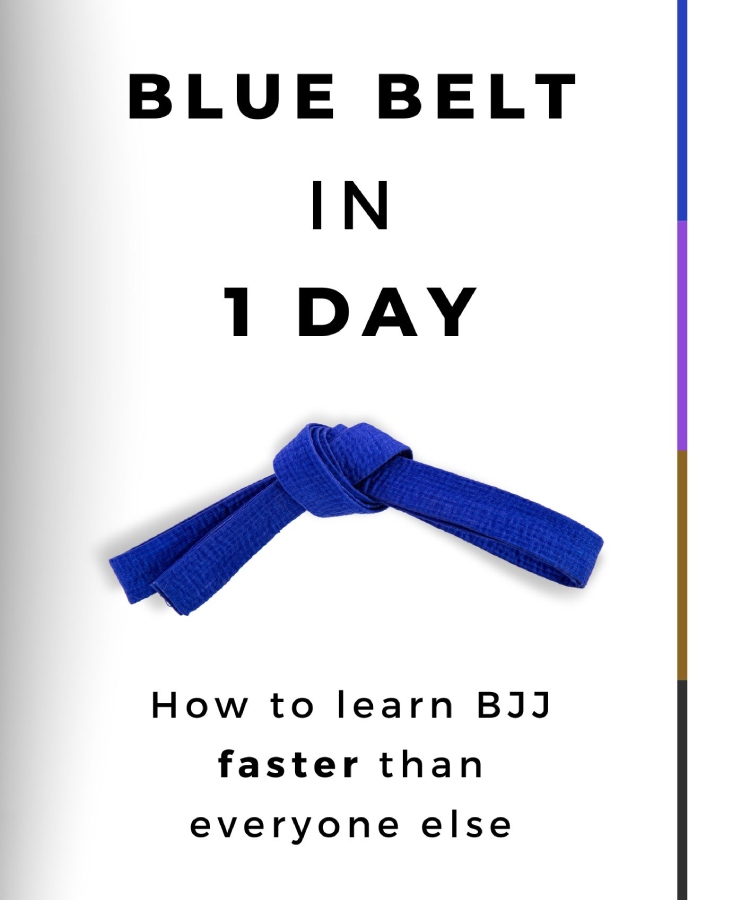On average, it will take between 1 and 3 years to get a BJJ blue belt.
However, some students receive their blue belt in Jiu Jitsu in less than 1 year, while other students may take far longer than 3 years before they get promoted to BJJ blue belt. With consistent training, you can often obtain a blue belt within 1-2 years.
Earning your Brazilian Jiu Jitsu blue belt is the first major milestone in your Brazilian Jiu-Jitsu belt journey.
But precisely how long will it take to get a blue belt in BJJ?
The exact answer depends on many factors.
I personally got my blue belt after 11 months of training. It took me another 4.5 years to get my purple belt, which is somewhat slower than average, so I can personally testify about the factors that affect the rate of promotion in the art of Jiu Jitsu.
In this article, I break down the various aspects that affect how long to get blue belt in BJJ based on the following aspects:
- My personal experience earning a BJJ blue belt
- Training factors that affect how long to get a BJJ blue belt
- Skill level needed for a BJJ blue belt
- How to get your blue belt faster
By the time you finish reading, you will have a complete understanding of what it takes to get a BJJ blue belt.

Since BJJ is an individual journey for everyone, its important not to compare yourself to other people when working towards your blue belt promotion.
As with all belts in BJJ, there are many reasons for the varied timelines regarding how long to get a blue belt in BJJ.
I have seen many white belts start BJJ and get promoted to blue belt over my 7+ years of training BJJ.
As such, I bring a good amount of firsthand and secondhand experience understanding what it takes to get a Jiu Jitsu blue belt having watched others work their way through BJJ white belt all the way to the higher belt levels.
Athletes with experience training in other martial arts such as Judo and wrestling which share similar positions and some techniques with Brazilian Jiu-Jitsu.
Calculate How Long to Get Your Blue Belt in BJJ
You can use my BJJ Blue Belt calculator below to estimate your time to get a blue belt in Jiu Jitsu and see how different things like supplemental materials can decrease that time.
BJJ Blue Belt Calculator
| Classes Per Week: | |
| Average Class Duration (minutes): | |
| Do You Compete? | |
| Prior Experience in Other Grappling? | |
| Supplemental BJJ Blue Belt Coursework? | |
Can you become a blue belt in BJJ in one year?
Yes, it's very possible to get your BJJ blue belt in one year. Training an average of 5-6 days per week, doing supplemental BJJ coursework, and competing in BJJ can potentially get you a blue belt in under a year. Use the calculator above and adjust the variables to see what it will take to get a blue belt after 1 year of BJJ training.
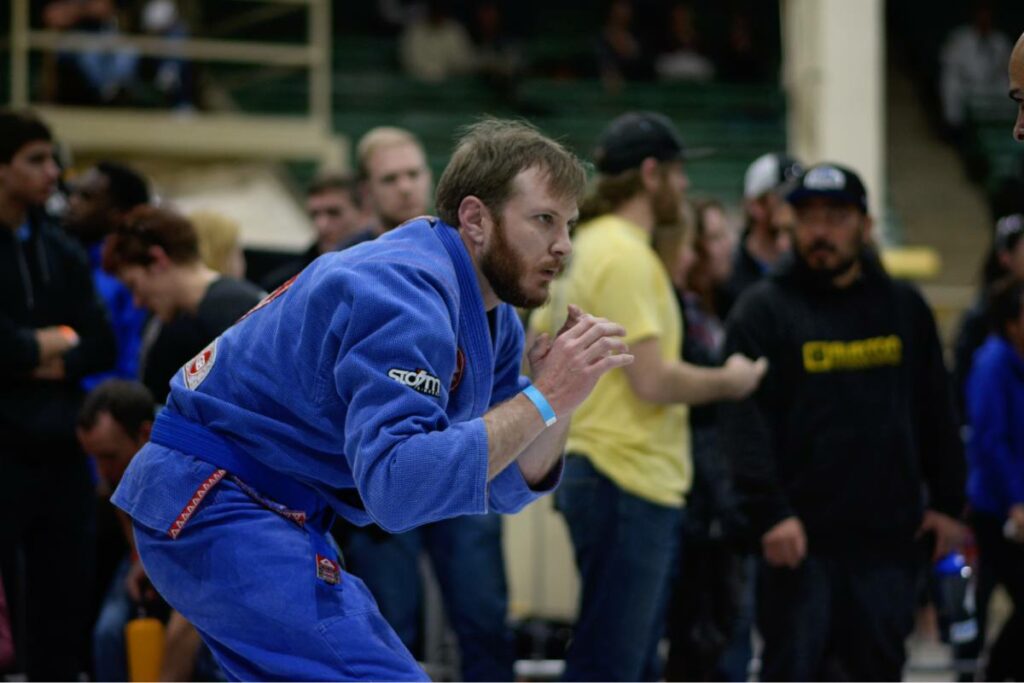
What is blue belt in Jiu Jitsu?
In the BJJ belt system, blue belt is the first colored belt rank a student will earn. The overall BJJ belt progression is as follows:
- White belt
- Blue belt
- Purple belt
- Brown belt
- Black belt
Within each rank in the BJJ belt system, students can earn stripes signifying progression through the belt rank. A stripe does not necessarily reflect how close you are to the next promotion, and some BJJ academies do not bother with giving out stripes between belts. However, schools that do stripe their students usually do a total of 4 stripes per belt rank.
Note that the kids’ Jiu Jitsu belt system differs in each color. Youths who are under 18 are eligible for blue belt after they have been a green belt for 2 years or longer, depending on the instructor and lineage.
BJJ Blue Belt Requirements
Each BJJ coach and Jiu Jitsu gym will have different technical knowledge requirements for blue belt.
Curriculum, lineage, and individual expectations for each student all play a role in how long it takes to earn a blue belt in Brazilian Jiu Jitsu. Generally, you'll need to be familiar with the major positions in BJJ and have a few technique options you are in each position.
Some argue that BJJ blue belt is among the hardest promotions to earn because you are going from complete lack of knowledge at the bottom of the totem pole and clawing your way towards skill level and recognition as a basic BJJ practitioner.
It’s easy to feel stuck at white belt, especially early into your journey when the skill set is so new.
While there are steps you can take to reduce the amount of time you spend at white belt, nobody can completely avoid the grind of white-to-blue belt.
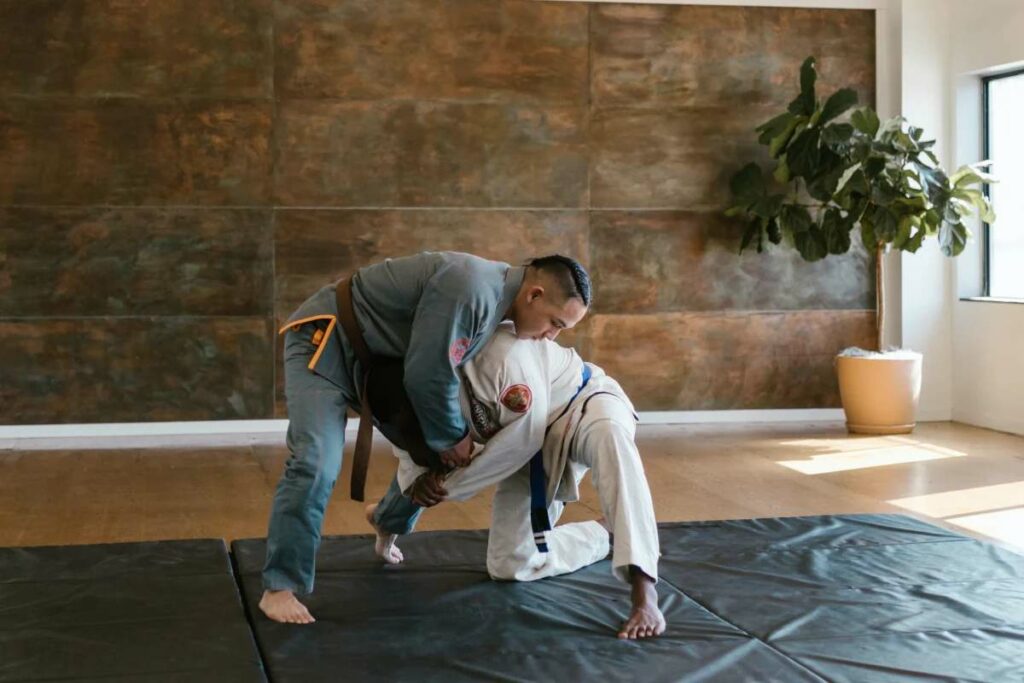
However, I personally found it took a lot more effort to get from blue to purple belt skill set than it did for white to blue, so it depends heavily on each individual person.
BJJ Blue Belt Reasons for Promotion
Generally speaking, a person with a blue belt will have a good understanding of fundamental body positions on the ground in Jiu Jitsu, including Jiu Jitsu side control, BJJ mount, back control, closed guard, open guard, knee on belly, and turtle.
You will also have a good knowledge of how to frame with your knees and leg, and some basic BJJ skills for self defense.
From a movement perspective, you should have some basic guard passes and sweeps under your belt as well.
Generally speaking, you should not be “stuck” in a position due to lack of knowledge, even if your opponent has the skills to shut down your escapes.
With some exceptions, blue belts will not necessarily have the ability to submit higher level opponents.
However, you will have knowledge of submissions overall and can typically tap out the average untrained opponent with relative ease without expending a ton of energy.
You should also be familiar with basic self-defense priciples.
While you may not have the footwork, strikes, kicks, and movements of professional fighters, you should understand striking range and other key self defense considerations.
Whether or not you compete in BJJ, you need to have a solid understanding of the rules of BJJ competition, since they correlate to positional knowledge in Jiu Jitsu.
Some academies have specific belt tests for each rank as well, but again, this is not universal.
Factors Affecting How Long to Get Your Promotion to BJJ Blue Belt

All instructors and gyms have different expectations for what they want out of someone holding the rank of blue belts.
Although time on the mats is not the only factor, how many hours of mat time you accrue and BJJ classes you attend affects how long to get blue belt.
The more your train, the faster you'll end up getting promoted, generally speaking.
Consider each training session the best measurement of actual development, as opposed to the months or years since starting BJJ.
Someone who does 3-4 training sessions per week will get promoted faster than someone training 1-2 times per week, all things being equal.
Rough Average Time to BJJ Blue Belt
The following table assumes you do not compete or do any other extracurricular learning.

Students who are faster learners will tend to level up quicker in BJJ as well. Unfortunately, we don’t all learn at the same rate, and BJJ belt levels are about knowledge, not simply checking off a number of classes attended.
Academies that emphasize sport BJJ competition may want to see you compete in one or more Jiu Jitsu tournaments before getting promoted, although this is not universally the case.
In some cases, a BJJ athlete may get promoted at a slower rate because the coach has higher expectations on performance.
However, since athletes often train more seriously, they may get promoted faster and have a higher level of skill within each belt rank.
As mentioned earlier, experience in other grappling arts also plays a major role, since Judo and wrestling share many similarities with BJJ, and if you come in already understanding the positional fundamentals, you are ahead of someone without this background knowledge.
Hobbyist BJJ practitioners may simply need to demonstrate the knowledge, skills, and dedication to the art, independent from their tournament accomplishments.
Age is also a major factor. The older you start in BJJ, the less expectation there is on athletic performance, but you will still be expected to know the same knowledge and positional skills for blue belt level.
To summarize, the following factors affect your rate of progress towards BJJ blue belt:
- Expectations from your instructor and academy
- Number of Jiu-Jitsu training sessions and mat hours accrued
- How fast you pick up techniques
- Whether you compete in BJJ or not
- Your age and prior experience in grappling martial arts
How to Make it Take Less Time to BJJ Blue Belt
I’m going to be honest, there is no way around putting in the work and grind on the mats when it comes to getting your BJJ blue belt.
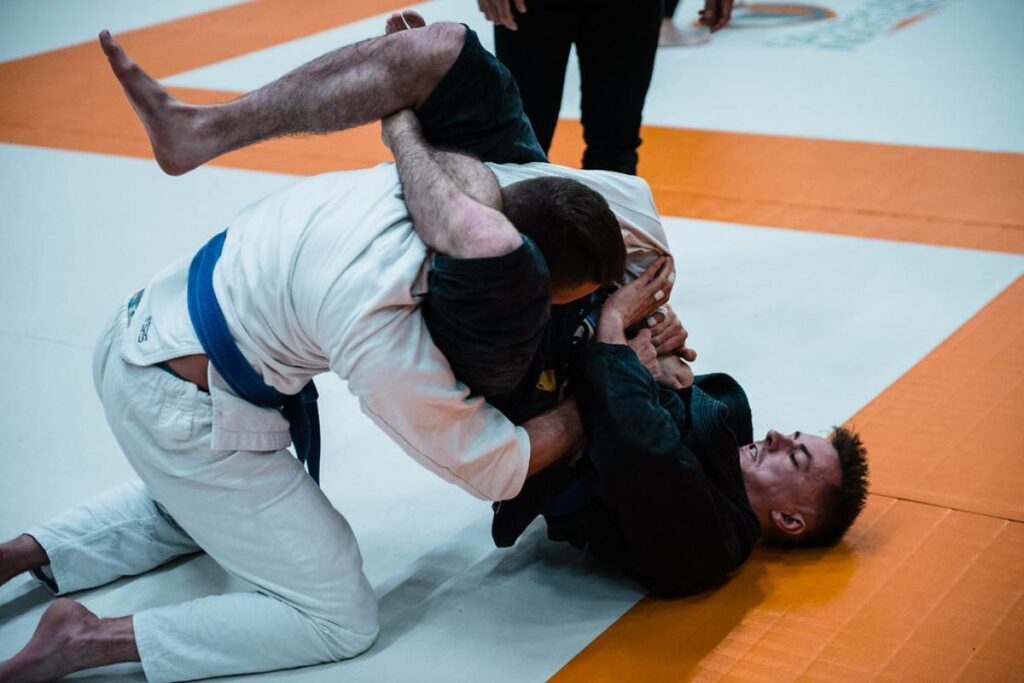
That being said, there are definitely some tips that I leveraged to get my blue belt in less than one year, allowing me to break that plateau quicker than some of my training partners and speed up my BJJ progress.
The first is to take notes in a training journal after class and write down and reflect the techniques you learned from your coaches. Also something to consider is writing down questions that came up in your mind during practice to revisit later.
The second tip is to focus first and foremost on surviving and escaping bad positions, rather than always hunting for the submission.
Techniques to Learn for BJJ Blue Belt
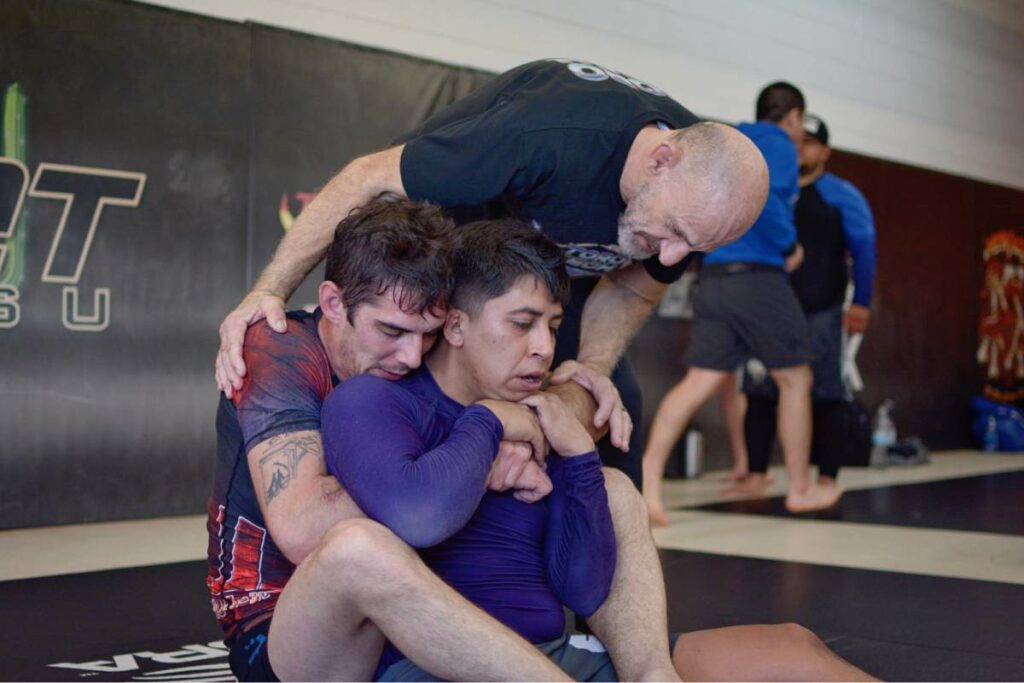
The following is a list of my top BJJ techniques you should focus on at white belt to speed up progress towards BJJ blue belt:
- Surviving bottom positions through defensive framing and choke defense
- Escaping from bottom and back control by shrimping, bridge-and-roll, and other escape techniques
- Establishing effective guard positions (ie butterfly guard, half guard, closed guard) after escaping from bottom
- Setting up sweeps and reversals from guard
Notice that learning submissions is not on this list. While you will obviously be learning some submissions at white belt, without the fundamental positional and escape techniques, you are unlikely to consistently get to strong positions that allow you to use submissions.
There is no point ironing out the details of a rear naked choke if you can’t even survive and escape from a bad position.
Having the discipline and dedication to focus on these fundamentals and respect for the details of each position is vital for becoming a well-rounded blue belt.
After all, barring fluke submissions like the buggy choke and ezekiel choke from bottom, you aren’t going to pull off many subs while your opponent is crushing you from a top position.
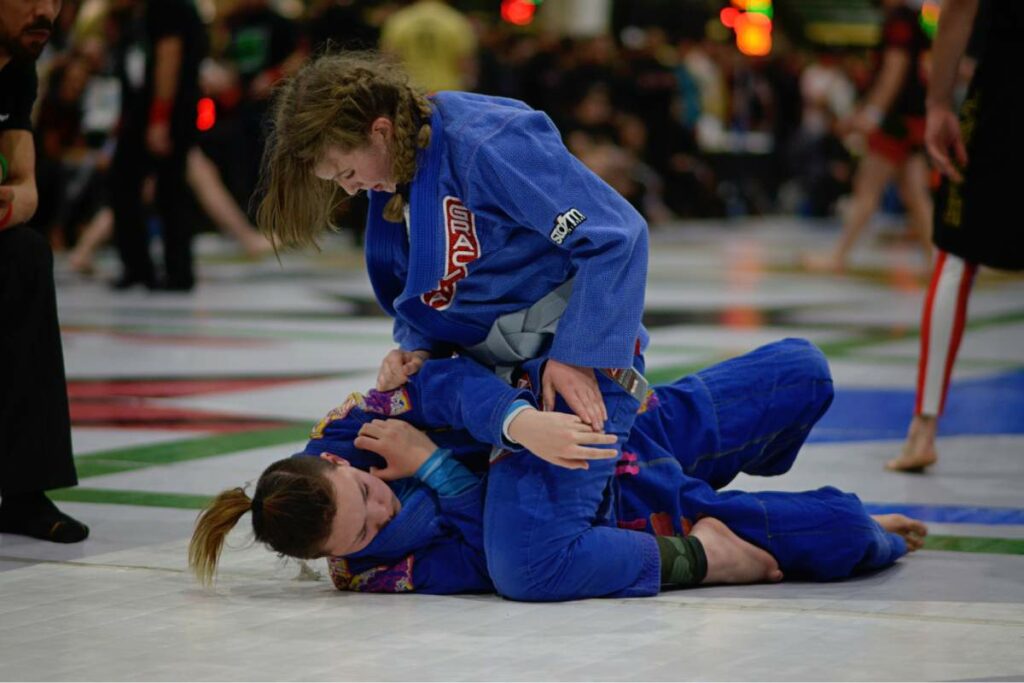
Hard work, dedication, and passion are also a must, but at the end of the day, BJJ is about position over submission, so don’t skip the fundamentals to chase submissions.
Cross Training in Other Martial Arts
Depending on your goals in martial arts overall, you may end up cross training. For example, I really wanted to compete in Mixed Martial Arts so I could try and use my BJJ skills in an MMA fight, which I figured was also more applicable to self defense and street combat scenarios.
With that said, at blue belt I began training in boxing, Muay Thai, wrestling, kickboxing, and MMA grappling. This actually slowed my progress towards getting my purple belt because a lot of these skills are not under the purview of traditional BJJ curricula.
However, I felt that the tradeoff was worth it to become a more well-rounded martial artist. If you are training BJJ for self defense, such as women looking to be able to beat larger male aggressors, cross training may be worth it to round out your skillset.
If you are a white belt who also wants to compete in MMA or train other arts, consider the fact that this may slow your progress towards blue belt.
The tradeoff may be worth it for your martial arts journey, but definitely consider this if your goal is to get blue belt as fast as possible.
I also have no disrespect towards traditional martial arts such as Chinese kung fu, wing chun, Japanese karate, and other arts.
Every martial artist has an individual journey throughout their life and training, and their is truly no right or wrong way to go about it.
However, I will reiterate that getting your blue belt as quickly as possible requires a highly-focused approach to training BJJ. Consider cross training after you get promoted to blue belt if that is your focus.
How Long To Get BJJ Blue Belt Frequently Asked Questions (FAQs)
Can you get a BJJ blue belt in 3 months?
Yes, its not unheard of to get a blue belt in 3 months, however this is by far the exception in terms of white-to-blue progression, and would require prior grappling experience and an intense dedication to training.
Is getting a blue belt in BJJ a big deal?
Getting a blue belt in BJJ is a big deal as it's your first major milestone on your BJJ journey.
However, always remember it is but one small step in the commitment to achieve BJJ black belt and journey to mastery.
How long will it take me to get a blue belt in BJJ?
Expect an average of 1 to 3 years to earn a BJJ blue belt. You can speed this up through training more, taking notes, and investing in courses.
What is the best way to prepare for blue belt testing?
If your Brazilian Jiu Jitsu curriculum includes a BJJ blue belt test, attend classes and focus on the techniques required on your test. Consult with your instructor for specifics for your BJJ academy.
What are the benefits of having a BJJ blue belt?
BJJ blue belts have fundamental knowledge of groundfighting positions, which can help in self defense. Additionally, its very satisfying to tie a colored belt around your waist to signify your dedication to the art.
What are some of the common challenges that blue belts face?
Once you get blue belt in Jiu Jitsu, upper belts will not take it as easy on you. Expect more pressure, higher expectations, and another uphill battle towards getting promoted to purple belt.
How Long to BJJ Blue Belt (Video)
Here’s BJJ Black Belt Jocko Willink breaking down his thoughts on how long to BJJ blue belt.





